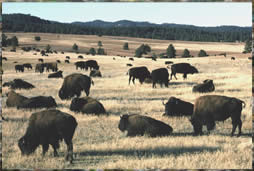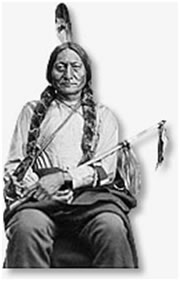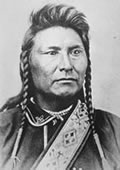Indian Stories: How Native Americans Saw Their World Disappear
Old Lady Horse: THE BUFFALO GO In the mid-nineteenth century, professional hunters severely thinned the herds of buffalo on the Great Plains; a single hunter might kill as many as 150 animals a day. Carriage owners in the East had developed a rage for buffalo hide lap robes, and smoked buffalo tongue had become a delicacy. To Indian hunters the near extinction of the buffalo meant the disappearance of their way of life, as a Kiowa woman named Old Lady Horse describes in this folktale. Everything the Kiowas had came from the buffalo. Their tipis were made of buffalo hides, so were their clothes and moccasins. They ate buffalo meat. Their containers were made of hide, or of bladders or stomachs. The buffalo were the life of the Kiowas. Most of all, the buffalo was part of the Kiowa religion. A white buffalo calf must be sacrificed in the Sun Dance. The priests used parts of the buffalo to make their prayers when they healed people or when they sang to the powers above. So, when the white men wanted to build railroads, or when they wanted to farm or raise cattle, the buffalo still protected the Kiowas. They tore up the railroad tracks and the gardens. They chased the cattle off the ranges. The buffalo loved their people as much as the Kiowas loved them. There was war between the buffalo and the white men. The white men built forts in the Kiowa country, and the woolly-headed buffalo soldiers [the Ninth and Tenth Cavalries, made up of black troops] shot the buffalo as fast as they could, but the buffalo kept coming on, coming on, even into the post cemetery at Fort Sill. Soldiers were not enough to hold them back. Then the white men hired hunters to do nothing but kill the buffalo. Up and down the plains those men ranged, shooting sometimes as many as a hundred buffalo a day. Behind them came the skinners with their wagons. They piled the hides and bones into the wagons until they were full, and then took their loads to the new railroad stations that were being built, to be shipped east to the market, Sometimes there would be a pile of bones as high as a man, stretching a mile along the railroad track. The buffalo saw that their day was over. They could protect their people no longer. Sadly, the last remnant of the great herd gathered in council, and decided what they would do. The Kiowas were camped on the north side of Mount Scott, those of them who were still free to camp. One young woman got up very early in the morning. The dawn mist was still rising from Medicine Creek, and as she looked across the water, peering through the haze, she saw the last buffalo herd appear like a spirit dream. Straight to Mount Scott the leader of the herd walked. Behind him came the cows and their calves, and the few young males who had survived. As the woman watched, the face of the mountain opened. Inside Mount Scott the world was green and fresh, as it had been when she was a small girl. The rivers ran clear, not red. The wild plums were in blossom, chasing the red buds up the inside slopes. Into this world of beauty the buffalo walked, never to be seen again. Sitting Bull, Life on the Sioux Reservation
Whatever you wanted of me I have obeyed. The Great Father sent me word that whatever he had against me in the past had been forgiven and thrown aside, and I accepted his promises and came in. And he told me not to step aside from the white man's path, and I am doing my best to travel in that path. I sit here and look around me now, and I see my people starving. We want cattle to butcher. That is the way you live, and we want to live the same way. When the Great Father told me to live like his people, I told him to send me six teams of mules, because that is the way the white people make a living. I asked for a horse and buggy for my children; I was advised to follow the ways of the white man, and that is why I asked for those things. Crazy Horse, Oglala Sioux; “I have spoken.” Crazy Horse, the great Oglala Sioux leader and hero of the Battle of the Little Bighorn, never had his photograph taken, and was on his deathbed before his thoughts were ever recorded on paper. Bayoneted by a Sioux guard at Fort Robinson, Nebraska, in 1877, he is supposed to have said these final words to Agent Jesse M. Lee. My friend, I do not blame you for this. Had I listened to you this trouble would not have happened to me. I was not hostile to the white man. Sometimes my young men would attack the Indians who were their enemies and took their ponies. They did it in return. We had buffalo for food, and their hides for clothing and our tipis. We preferred hunting to a life of idleness on the reservations, where we were driven against our will. At times we did not get enough to eat, and we were not allowed to leave the reservation to hunt. We preferred our own way of living. We were no expense to the government then. All we wanted was peace and to be left alone. Soldiers were sent out in the winter, who destroyed our villages. Then "Long Hair" [Custer] came in the same way. They say we massacred him, but he would have done the same to us had we not defended ourselves and fought to the last. Our first impulse was to escape with our squaws and papooses, but we were so hemmed in that we had to fight. After that I went up on Tongue River with a few of my people and lived in peace. But the government would not let me alone. Finally, I came back to the Red Cloud Agency.... I came here with the agent [Lee] to talk with Big White Chief, but was not given a chance. They tried to confine me, I tried to escape, and a soldier ran his bayonet into me. I have spoken. CRAZY HORSE, Oglala Sioux Chief Joseph's Lament
"Tell General Howard I know his heart ... What he told me before I have in my heart. I am tired of fighting. The old men are all dead. It is the young men who say yes or no. Tohoohoolzote [Joseph's brother] who led the young men is dead. It is cold, and we have no blankets. The little children are freezing to death. My people, some of them, have run away to the hills, and have no blankets, no food; no one knows where they are—perhaps freezing to death. I want to have some time to look for my children, and see how many I can find. Maybe I shall find them among the dead. Hear me, my chiefs, I am tired; my heart is sick and sad. From where the sun now stands, I will fight no more forever."
|

 The difficulties
of "assimilation" into white society were poignantly illustrated in
1883, when the Sioux leader Sitting Bull testified before a committee of the
United States that was visiting the Sioux reservation. The Sioux, like other
tribes forced to live under the Dawes Act, had become dependent on a dole of
blankets, food, and other necessities. Here, Sitting Bull tells the committee
how life had been after he had listened to the "Great Father" (the
president) and "came in" to the reservation.
The difficulties
of "assimilation" into white society were poignantly illustrated in
1883, when the Sioux leader Sitting Bull testified before a committee of the
United States that was visiting the Sioux reservation. The Sioux, like other
tribes forced to live under the Dawes Act, had become dependent on a dole of
blankets, food, and other necessities. Here, Sitting Bull tells the committee
how life had been after he had listened to the "Great Father" (the
president) and "came in" to the reservation. Very little
of the spoken eloquence of Native Americans has survived, for painfully obvious
reasons. But one great speech has become part of the American language. It was
given in 1877 by the man known to whites as Chief Joseph (or, in the tongue
of his people, Hinmaton-Yalaklit). He was a chief in the tribe that French explorers
had named Nez Percé--"pierced nose"--because of their practice of
wearing nose ornaments. When Joseph tried to lead a group of about 600 of his
people out of Idaho to Canada to avoid reservation life. the United States army
pursued them for over a thousand miles. On the long march, Joseph ran when he
could and fought when he had to. Finally, only about thirty miles from Canada, with winter coming on and with about half of his men already wounded, Joseph
surrendered.
Very little
of the spoken eloquence of Native Americans has survived, for painfully obvious
reasons. But one great speech has become part of the American language. It was
given in 1877 by the man known to whites as Chief Joseph (or, in the tongue
of his people, Hinmaton-Yalaklit). He was a chief in the tribe that French explorers
had named Nez Percé--"pierced nose"--because of their practice of
wearing nose ornaments. When Joseph tried to lead a group of about 600 of his
people out of Idaho to Canada to avoid reservation life. the United States army
pursued them for over a thousand miles. On the long march, Joseph ran when he
could and fought when he had to. Finally, only about thirty miles from Canada, with winter coming on and with about half of his men already wounded, Joseph
surrendered.